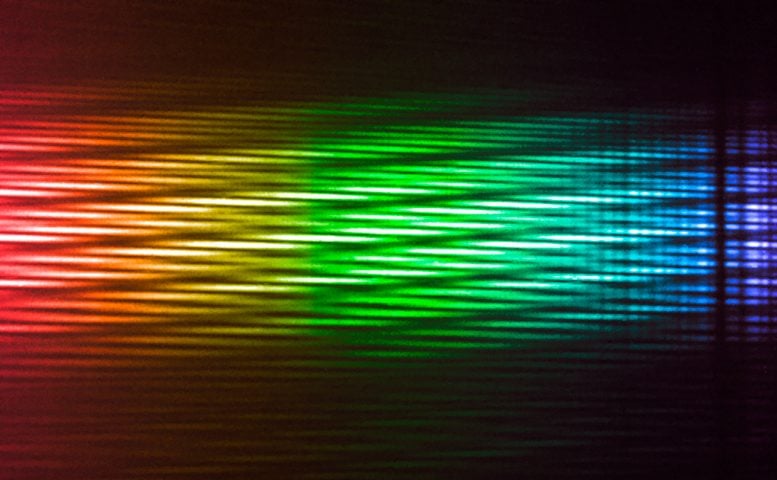
This image is a colorized version of the first MATISSE interferometric observations of the star Sirius, combining data from four Auxiliary Telescopes of the VLT. The colors represent the changing wavelengths of the data, with blue showing the shorter wavelengths and red the longer. The observations were made in the infrared, so these are not the colors that would be seen with the human eye. Credit: ESO/MATISSE consortium
The new MATISSE instrument on ESO’s Very Large Telescope Interferometer (VLTI) has now successfully made its first observations at the Paranal Observatory in northern Chile. MATISSE is the most powerful interferometric instrument in the world at mid-infrared wavelengths. It will use high-resolution imaging and spectroscopy to probe the regions around young stars where planets are forming as well as the regions around supermassive black holes in the centers of galaxies. The first MATISSE observations used the VLTI’s Auxiliary Telescopes to examine some of the brightest stars in the night sky, including Sirius, Rigel and Betelgeuse, and showed that the instrument is working well.
MATISSE (Multi AperTure mid-Infrared SpectroScopic Experiment) observes infrared light — light between the visible and microwave wavelengths of the electromagnetic spectrum, covering wavelengths from 3–13 micrometers (µm). It is a second-generation spectro-interferometer instrument for ESO’s Very Large Telescope that can take advantage of multiple telescopes and the wave nature of the light. In this way, it produces more detailed images of celestial objects than can be obtained with any existing or planned single telescope at these wavelengths.
After 12 years of development by a large number of engineers and astronomers in France, Germany, Austria, the Netherlands and at ESO, and following an extensive period of demanding work installing and testing this very complex instrument, initial observations have now confirmed that MATISSE is working as expected.
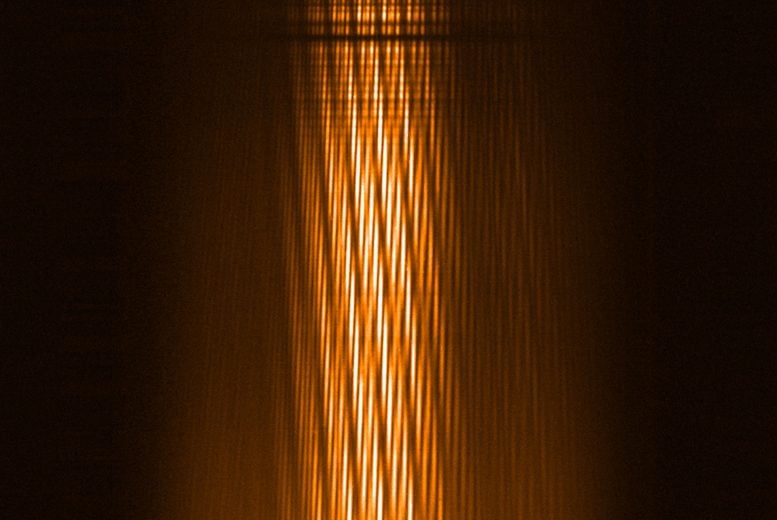
This strange picture shows the result of interfering the light coming from the four VLT Auxiliary Telescopes within MATISSE. Credit: ESO/MATISSE consortium
The initial MATISSE observations of the red supergiant star Betelgeuse, which is expected to explode as a supernova in a few hundred thousand years, showed that it still has secrets to reveal. The new observations show evidence that the star appears to have a different size when seen at different wavelengths. Such data will allow astronomers to further study the huge star’s surroundings and how it is shedding material into space.
The principal investigator of MATISSE, Bruno Lopez (Observatoire de la Côte d’Azur (OCA), Nice, France), explains its unique power: “Single telescopes can achieve image sharpness that is limited by the size of their mirrors. To obtain even higher resolution, we combine — or interfere — the light from four different VLT telescopes. Doing this enables MATISSE to deliver the sharpest images of any telescope ever in the 3–13 μm wavelength range, where it will complement the James Webb Space Telescope’s future observations from space.”
The short podcast gives a taste of MATISSE and what it will achieve. Credit: ESO
MATISSE will contribute to several fundamental research areas in astronomy, focusing in particular on the inner regions of discs around young stars where planets are forming, the study of stars at different stages of their lives, and the surroundings of supermassive black holes at the centers of galaxies.
Thomas Henning, director at the Max Planck Institute for Astronomy (MPIA) in Heidelberg, Germany, and MATISSE co-principal investigator, comments: “By looking at the inner regions of protoplanetary discs with MATISSE, we hope to learn the origin of the various minerals contained in these discs — minerals that will later go on to form the solid cores of planets like the Earth.”
Walter Jaffe, the project scientist and co-principal investigator from the University of Leiden in the Netherlands, and Gerd Weigelt, co-principal investigator from the Max Planck Institute for Radio Astronomy (MPIfR), Bonn, Germany, add: “MATISSE will give us dramatic images of planet-forming regions, multiple stars, and, when working with the VLT Unit Telescopes, also the dusty discs feeding supermassive black holes. We hope also to observe details of exotic objects in our Solar System, such as volcanoes on Io, and the atmospheres of giant exoplanets.”
MATISSE is a four-way beam combiner, meaning it combines the light collected from up to four of the 8.2-meter VLT Unit Telescopes or up to four of the Auxiliary Telescopes (ATs) that make up the VLTI, performing both spectroscopic and imaging observations. In doing so, MATISSE and the VLTI together possess the imaging power of a telescope up to 200 meters in diameter, capable of producing the most detailed images ever at mid-infrared wavelengths.
This selection of video clips shows the installation of the instrument at Paranal and the team during the first light observations. Credit: ESO/MATISSE consortium/P. Horálek
Initial tests were made with the Auxiliary Telescopes, and further observations with the four VLT Unit Telescopes are planned during the next few months.
MATISSE superimposes the light of an astronomical object from the combined light of multiple telescopes, resulting in an interference pattern that contains information about the appearance of the object, from which an image can then be reconstructed.
MATISSE’s first light marks a big step forward in the scope of current optical/infrared interferometers and will allow astronomers to obtain interferometric images with finer detail over a wider wavelength range than currently possible. MATISSE will also complement the instruments planned for ESO’s upcoming Extremely Large Telescope (ELT), in particular METIS (the Mid-infrared ELT Imager and Spectrograph). MATISSE will observe brighter objects than METIS, but with higher spatial resolution.
Andreas Glindemann, MATISSE project manager at ESO, concludes: “Making MATISSE a reality has involved the work of many people over many years and it is wonderful to see the instrument working so well. We are looking forward to the exciting science to come!”

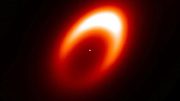
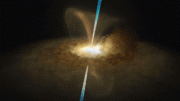
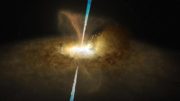


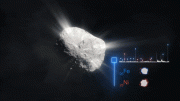
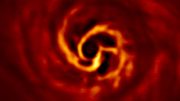

Star formation is one of the least comprehended phenomenon in astrophysics. Is there a general theory of star formation? No, there is not. There is a number of models based on computer simulations which include supersonic hydrodynamics with non-ideal MHD turbulence influenced by gravity. They include the line and continuum radiative processes of the energy transfer; a number of chemical processes with dissociation, recombination and ionization, with uncertain nomenclature of atoms and molecules, unknown magnetic fields and formation and destruction of dust particles. In addition there is macrophysics that is an environment in the molecular clouds, clumps and cores; inclusion in the multiple systems, collisions among stellar systems; jets and outflows; radiation pressure.